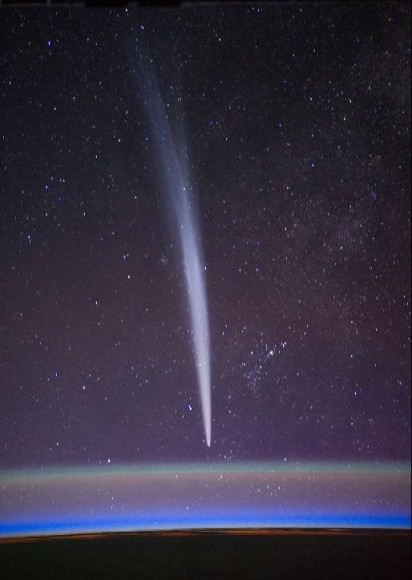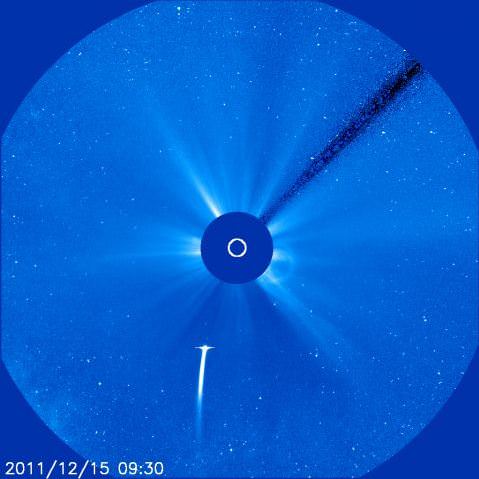Colin Legg from Esperance, Australia has been documenting Comet Lovejoy’s holiday gift to the southern hemisphere, and this is his latest — and possibly last — timelapse, as the comet has started to fade. This one covers almost 5 hours of Legg’s Comet Lovejoy views as seen during the early morning hours of December 27, 2011. “I used a tracking device to track in azimuth only to maximize coverage,” Legg said. “If you look closely at the head in the 2nd half you can see it moving against the stars.”
Absolutely Spectacular Photos of Comet Lovejoy from the Space Station
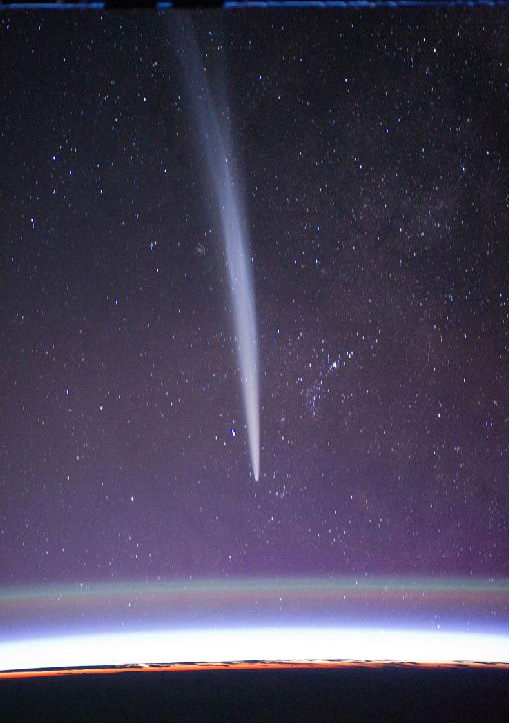
[/caption]
Check out this absolutely stunning collection of new Comet Lovejoy photos taken by space station commander Dan Burbank just before the Christmas holidays on Dec. 22, 2011 – what an amazing holiday treat, the Chrtistmas Comet!
Burbank shot these exquisitely detailed nighttime images showing the comet near the Earth’s horizon and framed with a gorgeously rich star field, all while floating aboard the International Space Station (ISS) some 400 kilometers (250 miles) above all of us – and absent any atmospheric interferences and distortions !
Burbank is a NASA astronaut and commander of ISS Expedition 30.
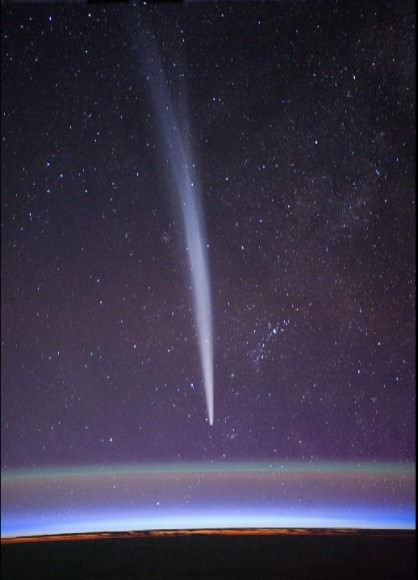
The comet has put on a spectacular show for observers in the Earth’s southern hemisphere despite prognostications of a fiery death as it careened through the suns corona during perihelion on Dec. 16 at a distance of 140,000 kilometers (87,000 mi).
Astronaut Burbank launched to the ISS on Nov. 13 along with Russian cosmonauts Anton Shkaplerov and Anatoly Ivanishin aboard the Soyuz TMA-22 capsule from the Baikonur Cosmosdrome. The trio docked on Nov. 16 for a more than 4 month stay.
Comet Lovejoy was only discovered on 27 November 2011, by Australian amateur astronomer Terry Lovejoy and classified as a Kreutz sungrazer. It has put on an unexpected and magnificent Christmas Comet holiday show.
Burbank first caught an accidental glimpse of Comet Lovejoy on Dec. 21 and snapped an initial set of beautiful comet photos from the Cupola observation dome aboard the ISS.
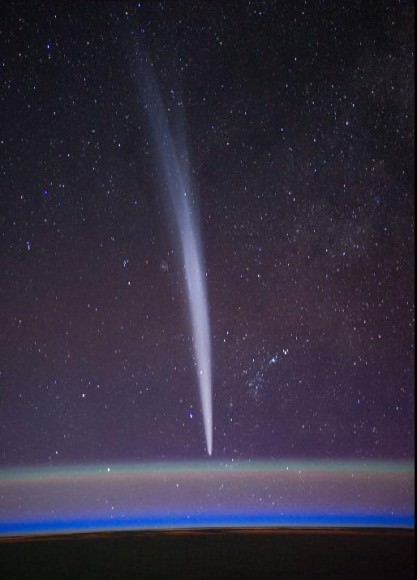
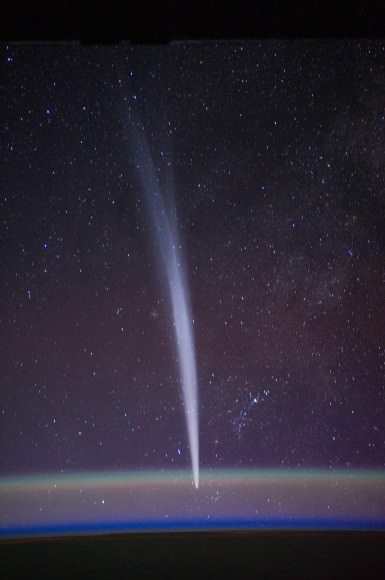
And – there’s still time to create an Asteroid Vesta themed winter holiday greeting card, here
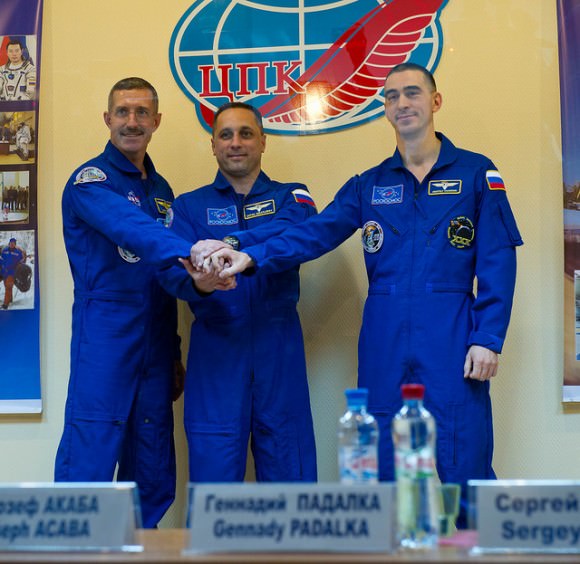
Stunning! Comet Lovejoy Photographed from the Space Station
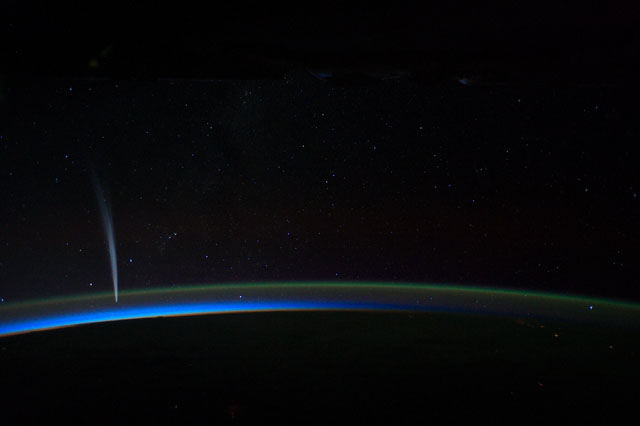
[/caption]
*Now updated with video!*
We can’t get enough of Comet Lovejoy! But this latest image is off the charts for its beauty and it’s jaw-dropping to contemplate it was taken from space. Dan Burbank, Expedition 30 commander onboard the International Space Station took this image of Comet Lovejoy on Dec. 21, 2011. See more of Burbank’s shots of Lovejoy here.
NASA now has a timelapse video of Burbank’s observations of Comet Lovejoy:
Surprising Comet Lovejoy Now Becoming Merry and Bright
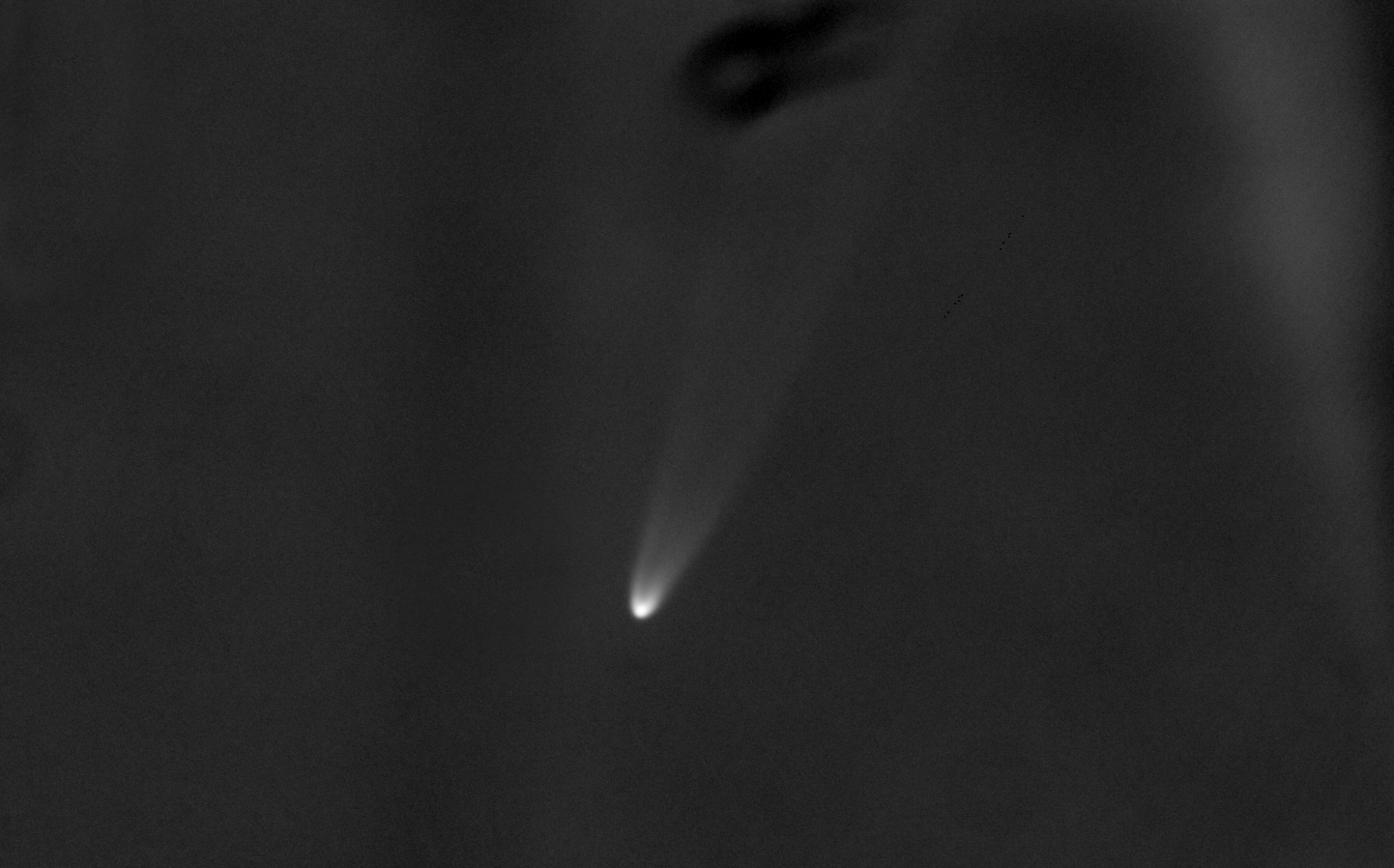
[/caption]
It was almost a pre-holiday miracle that Comet Lovejoy survived its close encounter with the Sun on Dec. 15, 2011. But now, the feisty comet is making a ‘merry and bright’ comeback, re-sprouting its tail and showing up brilliantly when seen with binoculars and in telescopic images from southern hemisphere skywatchers.
“It was a big surprise that after going through the solar atmosphere it re-emerged with a beautiful tail,” Karl Battams told Universe Today. Battams is with Naval Research Laboratory and has been detailing the Comet Lovejoy’s incredible journey on the Sungrazing Comets website. “And basically within a day it was as bright after the encounter as it was before.”
The beautiful image above was taken on Dec. 17, 2011, clearly showing two gorgeous tails on Comet Lovejoy. See more from the Czech team that took the image at their website, Kommet.cz.
As much as this comet has surprised everyone, no one is going out on a limb and predicting it will become visible with the naked eye. But who knows? The comet’s discoverer, Austrailian amateur astronomer Terry Lovejoy was able to image the comet in the day time! ” I am hopeful of a nice binocular comet low in the dawn around Christmas time,” Lovejoy said on the Ice in Space website.
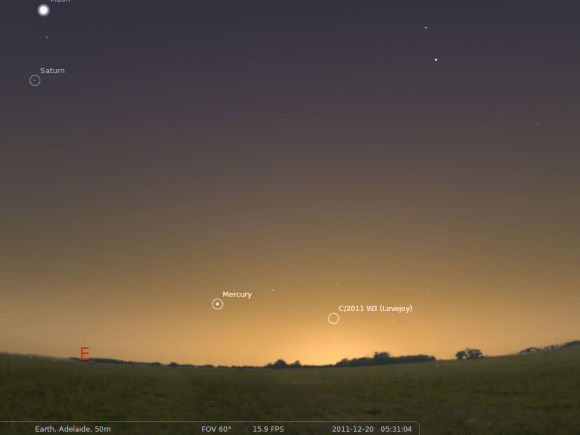
“Southern hemisphere viewers can see it now early in the morning,” Battams said via phone this morning. “It is going to become increasingly easy for them to see as it moves away from the Sun. I’m not sure it will increase in brightness anymore, as it has leveled off a little bit now. Odds are stacked in the favor of a nice nighttime show for southern viewers, and gradually it will fade away.”
Of course, Comet Lovejoy isn’t the only comet that has survived a close encounter with the Sun; in fact, some comets have even brightened to naked eye visibility after surviving a scorching from the Sun. The “Great Comets” of 1843 and 1882, and Comet Ikeya-Seki of 1965 were all Kreutz sungrazers – like Comet Lovejoy — and they all became brilliant after their solar encounters, with extraordinarily long tails.
Normally these comets don’t survive and are completely obliterated by the Sun. But the few that do – only 2 or 3 a century — can be very bright.
I had asked Battams on Friday – just after the comet emerged from behind the Sun – his thoughts on Comet Lovejoy and if it might follow the example of those previous surviving sungrazers.
“All bets are off as far as I’m concerned,” he wrote via email. “We thought this was a relatively small one — maybe a hundred or two meters in diameter. Clearly it can’t be. I did not expect it to survive perihelion as anything more than a diffuse blob that would rapidly dissipate. Instead it is pretty much as bright as it was before, just with less of a tail now.”
So keep a lookout for the holiday comet of 2011, the merry and bright Comet Lovejoy!
Best Look Yet of Comet Lovejoy’s Slingshot Around the Sun
There have been some great images and video of Comet Lovejoy’s close encounter with the Sun, but this video put together by Scott Wiessinger from Goddard Spaceflight Center combines and zooms in on the best views from the Solar Dynamics Observatory (SDO), which adjusted its cameras in order to watch the trajectory.
The first part of the video from SDO, (taken in 171 Angstrom wavelength, which is typically shown in yellow) was filmed on Dec 15, 2011 showing Comet Lovejoy moving in toward the Sun, with its tail “wiggling” from its interaction with the solar wind. The second part of the clip shows the comet exiting from behind the right side of the Sun, after an hour of travel through its closest approach.
No time travel with this slingshot around the Sun, but it is amazing to be able to follow this comet’s journey so closely!
Feisty Comet Lovejoy Survives Close Encounter with the Sun
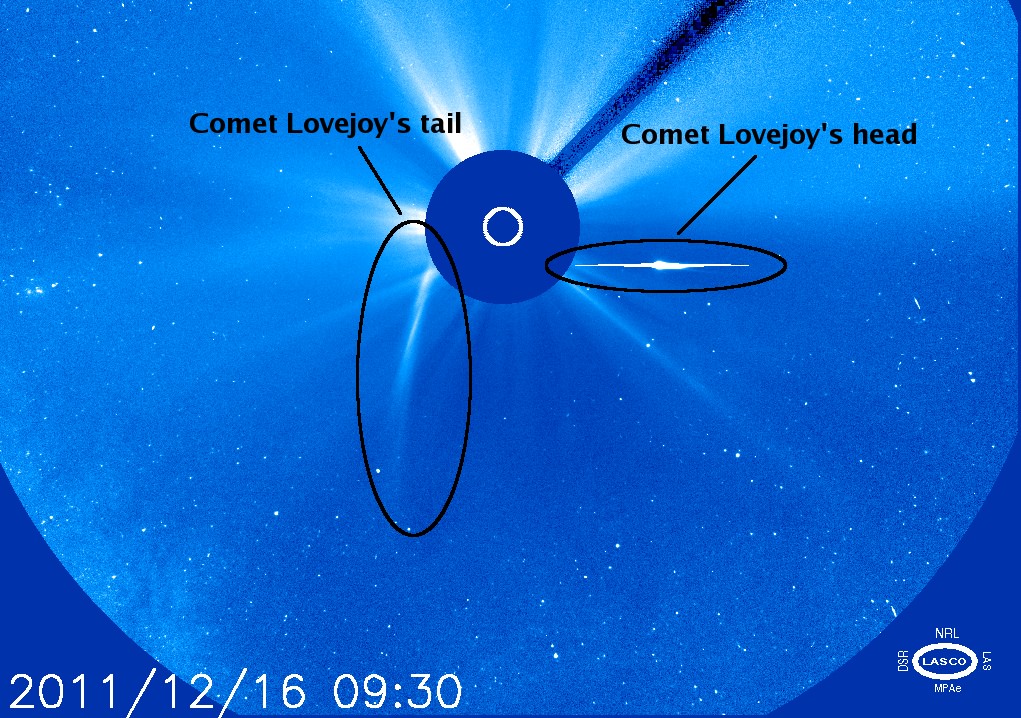
It’s the morning after for the sungrazing Comet Lovejoy, and this feisty comet has scientists shaking their heads in disbelief. “I don’t know where to begin,” wrote Karl Battams, from the Naval Research Laboratory, who curates the Sun-grazing comets webpage. “What an extraordinary 24hrs! I suppose the first thing to say is this: I was wrong. Wrong, wrong, wrong. And I have never been so happy to be wrong!”
Many experts were predicting Comet Lovejoy would not survive perihelion, where it came within about 120,000 km from the Sun. But some extraordinary videos by NASA’s Solar Dynamics Observatory showed the comet entering and then surprisingly exiting the Sun’s atmosphere. Battams said he envisioned that if the comet survived at all, what would be left would be just a very diffuse component that would endure maybe a few hours after its close encounter with the Sun. But somehow it survived, even after enduring the several million-degree solar corona for nearly an hour. However, Comet Lovejoy appears to have lost its tail, as you can see in the image below.
[/caption]
The comet is now in the view of other spacecraft, which will continue monitoring the object. It will likely grow a “new” tail as outgassing of dust, gas and debris will continue. It is not known yet how much of Comet Lovejoy’s core remains — which was 200 meters in diameter earlier this week — or how long it will continue to stay together after its close brush with the Sun.
But we’ll keep you posted!
See more videos of Lovejoy’s survival below:
Watch as Comet Lovejoy Takes a Death-Dive Into the Sun
A comet discovered on Dec. 2, 2011 is now on a near collision course with the Sun, and likely won’t survive such a close encounter. The best part is that you can follow along and watch as it happens! Comet C/2011 W3 Lovejoy will pass behind the sun at around 24:00 UTC (7 pm EST) on Thursday, Dec. 15, 2011 and probably won’t be seen again. In the video above, processed images from the STEREO A spacecraft shows Comet Lovejoy blazing towards the Sun, with the comet’s tail wiggling as it interacts with the solar wind.
The Solar Dynamics Observatory website has a special page where they will be uploading the latest images of the comet as it meets its fiery fate. As Comet Lovejoy moves toward perihelion, the SDO team will point SDO a little to the left of the Sun to try and see the tail of the comet with their instruments. This website will allow you to see those images as quickly as they can download them from the spacecraft.
Science live and in action!
Astronomers and various spacecraft have been keeping an eye on Comet Lovejoy the past few days as this Kreutz-group comet headed towards the Sun. Just today (Thursday) the images from the SOHO spacecraft showed the comet sprouting a bulbous head. This is occurring because the comet is getting so bright, it is overwhelming the detectors on the SOHO satellite. “The photons are ‘bleeding’ out to form that cross-like pattern,” said Dan Pendick on the Geeked On Goddard website.
Pendick also quoted solar scientist Jack Ireland from Goddard, who noted that at times two tails can be seen on the comet. “The thick white tail is primarily dust breaking away from the comet nucleus,” Ireland said, as the Sun’s radiation and solar wind that knocks material off the comet nucleus. But to the left is a tail of charged particles (ions) being deflected to the side by the magnetic field carried by the solar wind.
At its closest approach, Comet Lovejoy will pass just 120,000 km above the solar surface. At that distance, the icy comet is not expected to survive the Sun’s fierce heat. But the comet could actually disintegrate at any moment. Kreutz comets have a tendency to evaporate as they approach, or pass close to the Sun.
If the comet does stay the course and stay visible until it goes around the Sun, we likely won’t be able to see its demise because its closest approach will take place on the far side of the Sun.
But this is a great chance to watch this event as it is about to happen.
“We have here an exceptionally rare opportunity to observe the complete vaporization of a relatively large comet, and we have approximately 18 instruments on five different satellites that are trying to do just that,” wrote Karl Battams, from the Naval Research Laboratory, who curates the Sun-grazing comets webpage, and has been documenting Lovejoy’s journey.
Amateur astronomers have been trying to capture this event as well, with everyone wondering how bright the comet will get. For updates from amateur astronomers, check out the Yahoo Groups comet observers forum.
Comet C/2011 W3 Lovejoy was actually discovered by an amateur, Australian astronomer Terry Lovejoy (hence the comet’s name.) This is the first Kreutz comet found from a ground-based observer since 1970, and it was spotted with a modest 8″ telescope too! You can read Lovejoy’s tale of his discovery here.
On average, new Kreutz-group comets are discovered every few days by spacecraft like SOHO, but from the ground they are much rarer to see and harder to discover.
“This is the first ground-based discovery of a Kreutz-group comet in 40 years, so we really can’t be sure just how bright it will get,” said Battams. “However, I do think that it will be the brightest Kreutz-group comet SOHO has ever seen.”
Comet Lovejoy’s spectacular progress can also be monitored via the web at SOHO’s LASCO instrument page.
For the SDO special webpage, images from SDO take about 30 minutes to move from the spacecraft until they are available on the website. The SOD team plans to off-point the spacecraft at 23:30 UTC (6:30 pm ET) and return to normal solar observing at 12/16 00:30 UTC (7:30 pm ET). Images should start arriving by 24:00 UTC (7 pm EST.)

